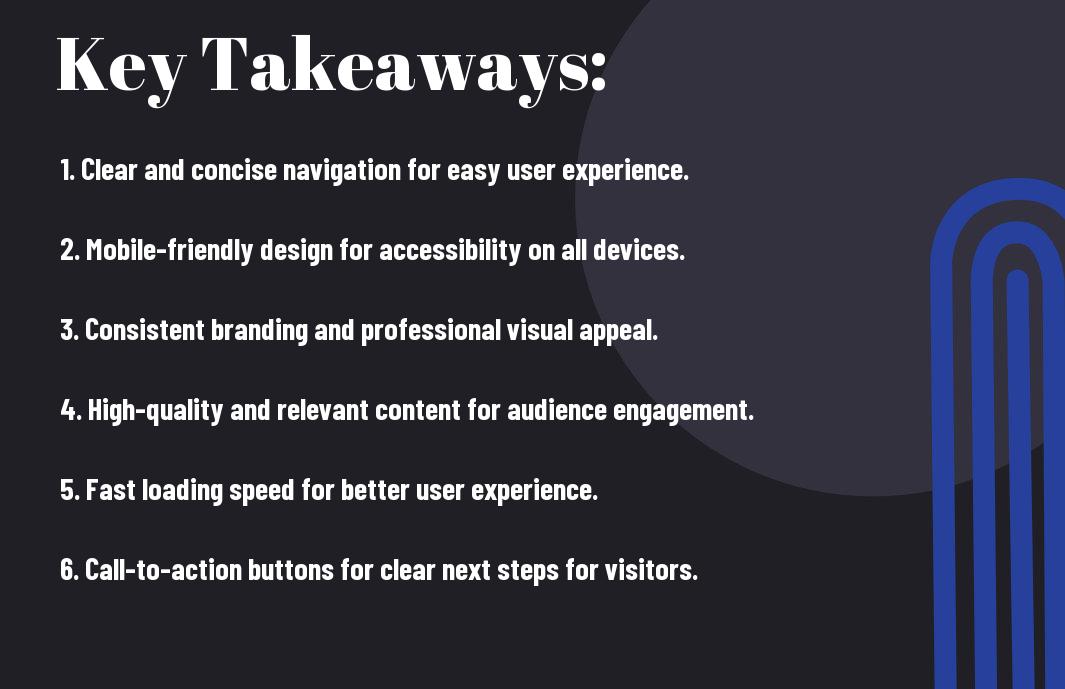Are you struggling to come up with a website design that effectively represents your small business? It can be a daunting task, but with the right tips and guidance, you can create a website that not only looks great, but also drives traffic and converts visitors into customers. In this blog post, we will provide you with valuable insights on how to design a website that is both simple and effective, ensuring that your small business stands out in the digital realm. From choosing the right color scheme and layout to optimizing for mobile devices and incorporating clear calls-to-action, we’ve got you covered. Keep reading to learn how to elevate your online presence and attract more customers to your business.
Key Takeaways:
- Clear and Intuitive Navigation: Emphasize easy navigation to keep visitors engaged and help them find what they are looking for quickly.
- Consistent Branding: Ensure that your website’s design and content are consistent with your brand’s identity to build trust and recognition with your audience.
- Mobile-Friendly Design: Optimize your website for mobile devices to accommodate the growing number of mobile users and improve overall user experience.
- Minimalistic Design: Keep your website clean and clutter-free to prevent overwhelming visitors and focus their attention on the most important information and calls-to-action.
- High-Quality Content: Provide valuable and relevant content to capture visitors’ interest and encourage them to explore your website further.


Clearing the Clutter
Obviously, when creating a website for your small business, you want to provide visitors with a clean and clutter-free browsing experience. A cluttered website not only looks unprofessional but can also confuse and overwhelm your visitors, leading them to leave and seek information elsewhere. To keep your website design simple and effective, consider following the 10 Important Web Design Best Practices and Tips for Small Businesses.
The Role of White Space
White space, also known as negative space, is the empty space between elements on a page. It may seem counterintuitive, but white space is incredibly important in website design. It allows your content to breathe, making it easier for your visitors to focus on the important elements. By including ample white space in your website design, you can draw attention to key areas, improve readability, and create a sense of elegance and sophistication.
Simplifying Navigation
When it comes to creating a simple and effective website design, the importance of streamlined navigation cannot be overstated. Your visitors should be able to navigate your website with ease, finding the information they need without getting lost or frustrated. Consider implementing a clear and intuitive menu structure, using descriptive labels for navigation links, and including a search function for easy access to specific content. By simplifying navigation, you can keep your visitors engaged and guide them towards your desired conversion points.
Visual Hierarchy and Content Layout
For a small business website, it is important to create a visual hierarchy that guides your visitors through the content. This not only helps them understand your message but also makes the overall experience more enjoyable. You can achieve this by following a few simple design principles. For more in-depth information on this topic, you can refer to the Top 10 Proven Website Tips for Small Businesses.
Establishing Focal Points
When creating your website layout, it’s important to establish focal points that draw the visitor’s attention to the most important parts of the page. Whether it’s a call-to-action button, a featured product, or a compelling piece of content, using visual cues such as size, color, and placement can help guide your visitors’ focus. This can significantly improve user engagement and conversion rates.
Organizing Your Content Effectively
An effective layout also involves organizing your content in a way that is easy to digest. By breaking up large blocks of text with headlines, subheadings, bullet points, and visuals, you can make it easier for your visitors to scan and find the information they are looking for. This not only improves the user experience but also conveys your message more effectively. Additionally, using white space strategically can help avoid clutter and keep your design clean and professional.
Optimizing for User Experience
Now, when it comes to creating a small business website, optimizing for user experience should be a top priority. One way to ensure a great user experience is by implementing the 15 Essential Small Business Website Design Tips &… that you can find on localiq.com. These tips cover everything from design to functionality, help you create a website that is both simple and effective for your users.
Mobile Responsiveness
Ensuring that your website is mobile responsive is crucial for providing a positive user experience. When your website is not optimized for mobile devices, you risk losing a large portion of your potential audience. With more and more people using their smartphones and tablets to access the internet, having a mobile-responsive site is no longer a nice-to-have, but a must-have. Your website should automatically adjust to fit any screen size, providing an optimal viewing experience for all users.
Fast Load Times
Another essential aspect of user experience is the speed at which your website loads. No one likes waiting for a website to load, and slow load times can drive potential customers away. You can improve load times by optimizing images, using browser caching, and minimizing the use of plugins and scripts. A fast-loading website not only improves the user experience but also positively impacts your search engine rankings.
By optimizing for user experience, you can create a website that not only looks great but also functions seamlessly for your visitors. Paying attention to mobile responsiveness and load times will ensure that your website is accessible and enjoyable for all users.
Branding and Aesthetics
Keep in mind that your website is a visual representation of your small business, and it is crucial to establish a strong brand identity through your design. Consistency in branding elements, color scheme, and typography is key to creating a memorable and professional look for your website.
Consistent Branding Elements
When it comes to branding, consistency is key. Your logo, color palette, typography, and overall visual style should be consistent across all pages of your website. This creates a cohesive and professional look that helps to build trust with your visitors. Make sure that your logo is prominently displayed and easily recognizable, and use it consistently throughout your website. Additionally, use the same typography and color palette across all pages to maintain a cohesive brand identity.
Choosing the Right Color Scheme and Typography
Choosing the right color scheme and typography is crucial for creating a visually appealing and effective website design. Your color scheme should reflect your brand personality and be visually appealing to your target audience. Avoid using too many different colors, as this can be overwhelming and detract from your overall message. Similarly, your choice of typography should be consistent with your brand and easy to read. Using legible fonts and maintaining a good balance of font sizes will ensure that your content is easy to consume.
FAQ
Q: Why is it important for a small business to have a simple and effective website design?
A: Having a simple and effective website design is crucial for small businesses as it creates a strong online presence, enhances user experience, and helps in attracting and retaining customers.
Q: What are some key tips for creating a simple and effective website design for a small business?
A: Some key tips include keeping the design clean and uncluttered, using easy navigation, ensuring mobile responsiveness, and incorporating clear calls to action.
Q: How can I make my small business website design visually appealing?
A: To make your website visually appealing, use high-quality images, a balanced color scheme, attractive typography, and white space to enhance readability and focus.
Q: What role does website speed play in the effectiveness of a small business website design?
A: Website speed is crucial for user experience and search engine rankings. Ensure your website loads quickly to keep visitors engaged and minimize bounce rates.
Q: How can I ensure that my small business website design is user-friendly?
A: To ensure user-friendliness, conduct usability testing, optimize forms and checkout processes, provide clear and concise content, and make sure all the links and buttons are easily clickable.
